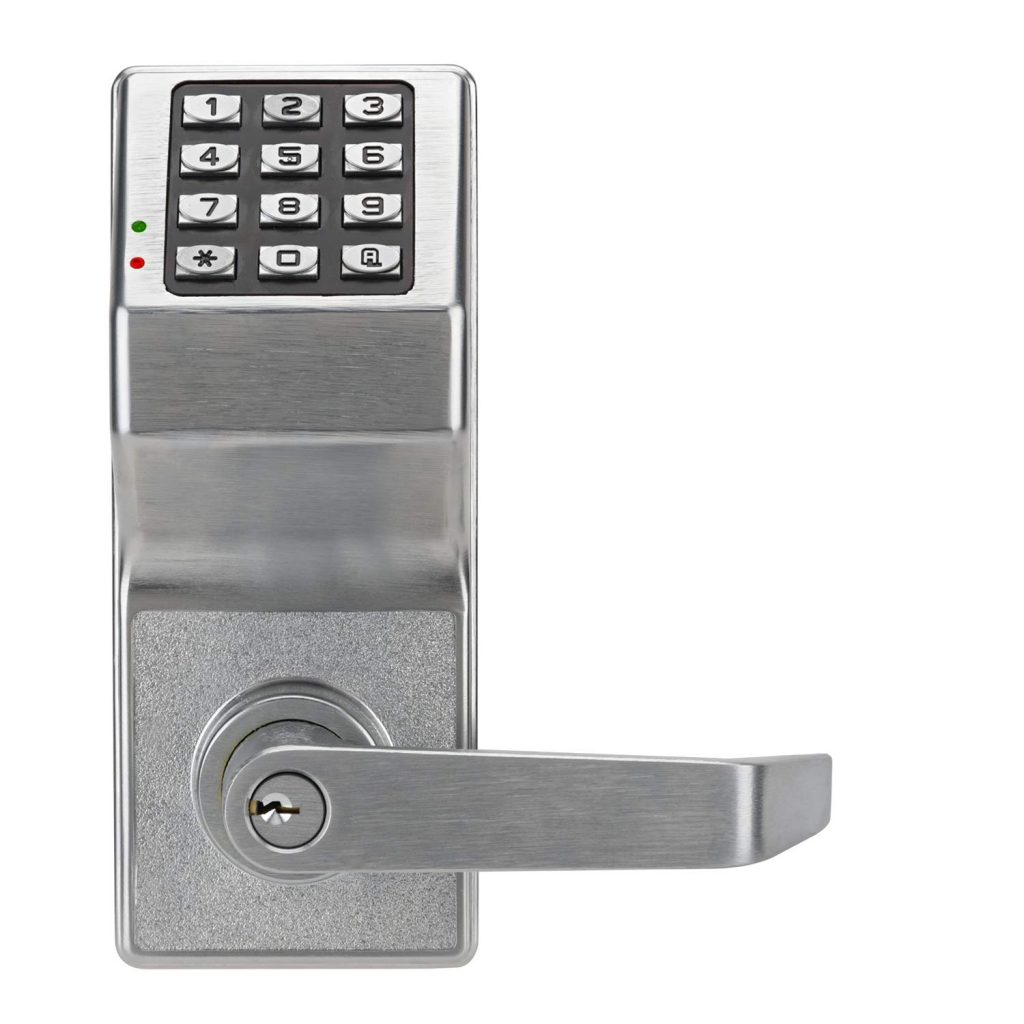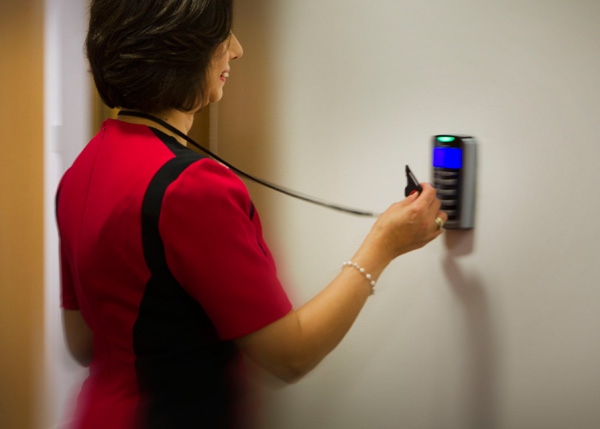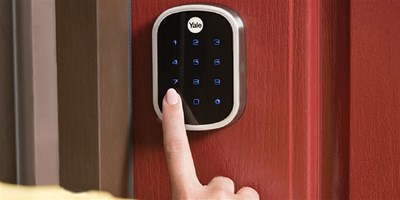Now more than ever, businesses look to control access to their buildings through means other than giving out keys. Finding ways to create key-free lock control can add security in many ways. First and foremost, giving out too many keys can lead to issues down the road. Former employees may end up having access to your business well after they should. Additionally, some key-free security measures also grant business owners remote control over their building’s locks. This can add a tremendous amount of security and convenience. In this post, we share our top methods of granting this security and control for our commercial customers.
First, we will look at a couple keypad lock options for businesses. From there, we will look at the many security benefits of installing access control. Access Control systems help businesses both limit and track access to a building. Next, we will explore options for intercom systems that give those inside an office the ability to communicate with and grant access to visitors. Finally, we will focus on smart locks that allow complete offsite control of a property’s locks. Let’s begin with a look at both standalone and electronic keypad locks!

Standalone keypad levers, such as this one by Trilogy, allow businesses to install keypad lock security without installing additional hardware or running wires.
Keypad Locks
Creating keypad lock control addresses many of the security concerns regarding giving out too many keys. In this section, we will examine a couple ways that we create this security. First, we will look at “standalone” keypad levers that we install on doors to allow key-free lock control. These keypads can help lock down more important areas of a business, while allowing authorized employees to use their codes to enter. From there, we will look at installing electronic keypads. These keypads work with electronic locking hardware as a heavier-duty option than keypad levers provide.
Standalone Keypad Levers
As you might have guessed by the description, we install “standalone” keypad levers on doors without the need to install additional equipment. These levers have battery-operated keypads that allow users to program multiple codes to unlock a door. Using multiple codes allows business owners to add and delete codes as access levels change or as businesses experience employee turnover. The ability to control access to certain areas of a business while installing as little equipment as possible makes these keypads a popular addition for many businesses. In addition to installing standalone keypad levers, we can also offer key-free lock control by installing keypads and electronic lock hardware to provide this security. Now, let’s take a look at what’s involved in creating this electricity-driven keypad lock solution.
Electronic Keypads That Control Locks
In some cases, installing standalone levers on doors is not the best option for business owners. For example, in many cases a door has an exit device (often referred to as a “crash bar”) in place rather than just a lever. Many exit devices will not function properly if we attempt to install a keypad on the other of the door. This takes away the option of installing a standalone keypad. Additionally, aluminum doors often do not have sufficient space to install a keypad lever.
In these instances, we install a keypad that controls electronic locking devices installed on the door’s frame to provide key-free lock control. We can install our keypad anywhere in the vicinity of the door it controls, allowing users to punch in their code and electronically unlock a door without changing any of the hardware on the door itself. Now that we’ve looked at a couple keypad-related locking configurations, let’s take a look at how access control takes keyless entry one step further!
Access Control

Installing access card readers, such as this one made by AMAG, provides keyless security for specific areas of your business.
Access control systems utilize the same type of electronic locking devices that we use when installing electronic keypads. However, these systems have a couple major differences. For starters, users generally present a “credential” of some sort, rather than typing a code, to gain access. For example, proximity fobs or cards such as the one pictured make popular credentials. Users scan these credentials in front of a reader to activate the electronic locking hardware and gain access. As an alternative, some readers allow for users to scan their phones as a credential.
Additionally, we can also install biometric scanners as part of an access control system. These readers allow users to enter a door based on a biometric feature such as a fingerprint, handprint, or even an eye scan! Furthermore, we connect access control systems to software that tracks who enters a door, and when. If desired, credentials can also be programmed to only work during certain time frames. The security and flexibility offered by these systems make them a great addition to any commercial security plan. For more information on these systems, check out our post on The How, Where, When, and Why of Access Control. Now, let’s see how buzzer and intercom systems can make office life more secure and convenient for employees.
Buzzer or Intercom Systems with Lock Control
Most of us have likely had to press a “buzzer” to gain entry into an office or school. After hearing the buzzer, someone inside can press a button that remotely unlocks the door. These systems use the same type of hardware that we use for electronic keypads and access control systems. However, a simple buzzer system does not allow for communication between the person outside and the person unlocking the door.
To address this issue, we install intercom systems that create this communication. Audio intercom systems allow visitors to talk to someone inside the office while still outside. We also offer video intercom systems that even allow office personnel to see the area around the door before making the decision to unlock it. This type of setup allows busy workers to answer the door without getting up from their desks. It also creates security by allowing workers to gather information before determining that unlocking the door for their visitor is a safe option. Let’s take a look at one more technology-driven option that offices use to create key-free lock control!

Smart locks, such as this model by Yale, create added convenience as well as security.
Smart Locks
You may remember our section on smart locks from our Smart Technology Solutions for Your Business. Up to this point, we have discussed locks that require users to be onsite to activate. Smart locks, on the other hand, can be controlled from anywhere. These locks are internet-connected keypad locks that allow authorized users to lock and unlock their doors remotely from a smartphone, computer, or tablet. Business owners can check on their status of their locks and ensure that their property remains secured at all times. Additionally, these locks create the ability to grant contractors or other visitors one-time access to a building without providing a key, a keypad code, or a credential that could be used to breach your security later on. Smart locks eliminate the need to take a trip to the office just to let someone into the building, making them a very popular business security measure!
Using Key-Free Lock Control to Secure Your Business
We hope that this post has given you some ideas for adding key-free lock control to your own business. Please do not hesitate to contact us if you have any questions about the material in this post. We offer free site surveys for businesses to assess lock security, as well as overall business security. While on site, we can address any concerns you may have. Additionally, we can make our own recommendations based on what we see. Addressing door security plays a major role in any business’s security plan. Together, we can come up with a plan to keep your property as safe and secure as possible!
